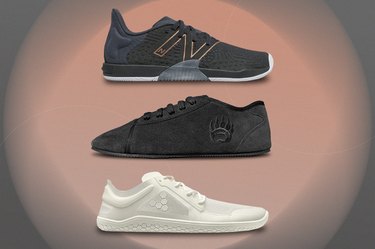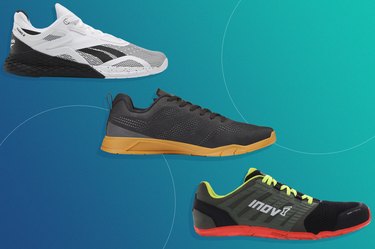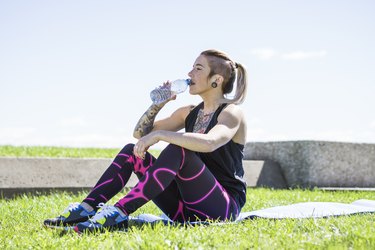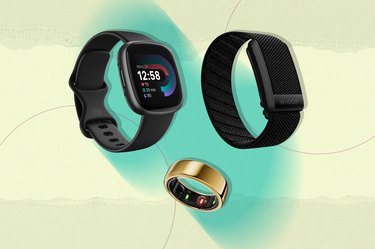



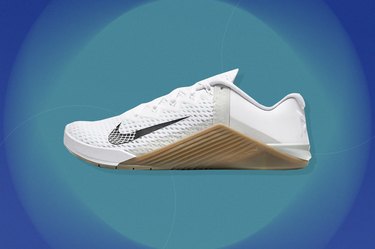
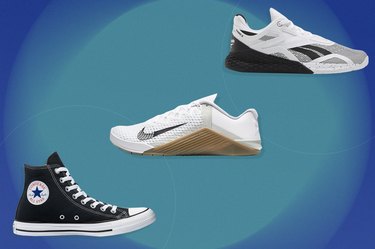
Who here has worn their running shoes in the weight room? Really?! OK, put down your hand. It's time to invest in a pair of legit weightlifting shoes.
Nope, weightlifting shoes are not a gimmick. They're a super-simple way to help you move better through your squats, deadlifts, cleans and, ultimately, lift more weight.
Video of the Day
Video of the Day
How's that work? Lifting shoes are usually flat with a rigid sole, minimal cushion and a well-fitted upper. This helps you really feel and grip the ground under your feet during your deadlifts and prevent sliding during side lunges.
"Imagine trying to squat your one-rep max on a BOSU ball, and it becomes obvious why you don't want any instability," Yuen says.
Meanwhile, some shoes are squat-specific and have a raised heel designed to help you get lower farther toward the ground (more on that below). In fact, in an April 2016 study Journal of Sports Sciences study, researchers found that wearing weightlifting shoes (versus athletic sneakers) improves range of motion through the ankles and knees and supports proper back alignment.
Sold yet? Check out these five best weightlifting shoes and learn what to look for when you buy.
Manufacturers typically market shoes according to gender, so we have listed both women's and men's picks below. However, the main difference between most men's and women's shoes lies in the shoe width and size. In some cases, men's shoes are built to support greater weights. So people with bigger bodies may want to opt for men's versions, whereas people with smaller bodies may prefer women's versions.
1. Reebok Legacy Lifter II
Best for your leg workouts, the Legacy Lifter shoes have an elevated heel to help you sit deep into your squats. After all, squatting low to the ground is hard when you have tight calves or lack mobility in your ankles, according to Carolina Araujo, CPT, a New York-based certified personal trainer. These lifters give you a little leg up (pun intended) by tilting your ankles forward.
"Although squatting to 90 degrees will still help you strengthen your glutes and legs, squatting low to the ground takes it up a notch," she says. "However, a lot of people don't have the mobility to do it properly. Lifters will help with that."
Buy it: Reebok.com (men's); Reebok.com (women's); Price: $200
2. Reebok Nano X
Although these shoes may look like running sneakers, their cushion is actually pretty minimal, which is exactly what you want with a good pair of lifting shoes, says New York-based physical therapist Cameron Yuen, DPT. In your lifting shoes, you want to feel the ground beneath your toes. This helps you really drive through your lower body for the strongest, safest lifts.
But don't assume anything about these shoes is stiff. They have a flexible upper that promises both stability and breathability — no one wants sweaty feet when they're lifting heavy weights.
Buy it: Reebok.com (men's); Reebok.com (women's); Price: $130
3. Converse Chuck Taylor All Star High Top
You may be surprised to see these on the list, but Chucks have a cult-like following in the strength-training world. And they get Yuen's seal of approval, too. "Chuck Taylors are standard powerlifting shoes due to their flat and relatively cushion-free sole."
While they're not as high-tech as some of the other options out there — after all, they're not actually designed for exercise — Converse shoes do provide a solid foundation. When wearing barefoot lifting shoes like these, lace them up tight for maximal stability.
Buy it: Converse.com; Price: $60
4. NOBULL Lifters
Relatively new to the shoe scene, NOBULL offers both trainers and lifting-specific shoes, depending on your goals. For a squat session, the lifters are definitely the way to go.
"I really love that these are leather," Araujo says. "When you're squatting, you want your feet to stay in place, so these shoes will really provide a stable base. With the heel lift, you'll get a really good lower-body session."
Buy it: NOBULLProject.com (men's); NOBULLProject.com (women's); Price: $299
5. Nike Metcon 6
The Nike Metcon 6 is all about versatility in your strength workouts, Araujo says. They provide the stable base you need to lift but their flexible and breathable fabrics help you move seamlessly from the squat rack to a sled push.
They even come with different heel inserts you can swap out for different workouts. You can use the most minimal insole for heavy lifting, whereas the elevated options are ideal for sprint and jump-rope workouts when you want a little more cushion.
3 Tips to Find the Best Weightlifting Shoes for You
1. Cut Out Cushion
Typical running sneakers are cushioned and provide a lift in the heel, which can help with the high impact running puts on your joints, Yuen says. But when it comes to weightlifting, that extra cushion can work against you.
With lifting shoes, you want a good feel of the ground underneath your feet to give you as much stability as possible while you're carrying heavy weights.
2. Consider Your Workouts
Your personal workout routine will determine what kind of lifting shoes are best for you, Araujo says. If you like to hit the weights and only the weights, you can benefit most from a minimal, simple pair of sneakers, like the Converse above.
But if you like to weave some sprint intervals into your strength workouts, something more versatile, like the Metcon, will be a better fit.
3. Prioritize Comfort
Don't underestimate the importance of comfort while you're lifting weights, Araujo says. Just like you don't want to buy a pair of blister-causing running shoes, the same goes for your lifters.
Look for a shoe that allows you to spread our your toes as needed to get a better grip of the floor, she says.
